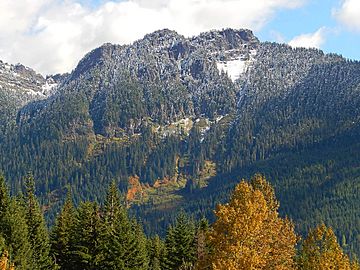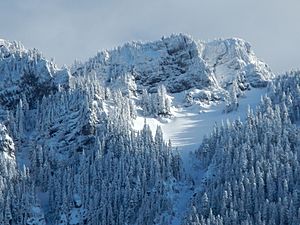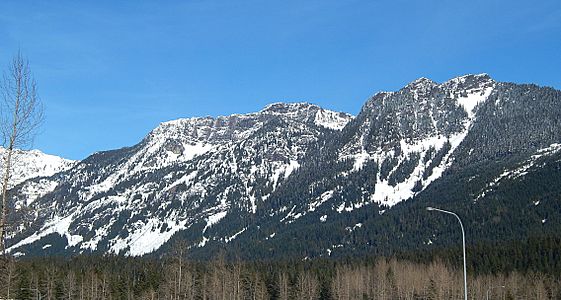Dungeon Peak (Washington) facts for kids
Quick facts for kids Dungeon Peak |
|
|---|---|

Dungeon Peak seen from Snoqualmie Pass area
|
|
| Highest point | |
| Elevation | 5,640+ ft (1,720+ m) |
| Prominence | 400 ft (120 m) |
| Parent peak | Rampart Ridge |
| Geography | |
| Location | Alpine Lakes Wilderness Kittitas County, Washington state, U.S. |
| Parent range | Cascade Range |
| Topo map | USGS Chikamin Peak |
Dungeon Peak is a mountain in Washington state, standing at 5,640+ ft (1,720+ m) tall. It is part of the Cascade Range and is found in Kittitas County.
This peak is located near Hyak, Washington, close to the northern end of Keechelus Lake. It sits within the beautiful Alpine Lakes Wilderness. The land around it is managed by the Wenatchee National Forest. Dungeon Peak's closest taller neighbor is Rampart Ridge, which is about 0.66 mi (1.06 km) away to the north. The mountain overlooks the Gold Creek valley on its west side and Lake Lillian on its east side. Water from the peak flows into streams that eventually join the Yakima River.
Mountain Weather: Dungeon Peak's Climate
Dungeon Peak experiences a "marine west coast" climate. This means its weather is strongly influenced by the nearby Pacific Ocean. Most of the weather systems start over the Pacific and move towards the Cascade Mountains.
When these weather systems reach the mountains, the air is forced to rise. As the air goes higher, it cools down. This cooling causes the moisture in the air to turn into rain or snowfall. This process is called Orographic lift. Because of this, the western side of the Cascade Mountains gets a lot of rain and snow, especially during winter.
Winters at Dungeon Peak are usually cloudy. However, during the summer, high-pressure systems over the Pacific Ocean often bring clear, sunny skies. The snow here tends to be wet and heavy. This can sometimes create a risk of avalanches. The best time to visit or climb Dungeon Peak is usually from July through September.
How Dungeon Peak Was Formed: Geology
The Alpine Lakes Wilderness is known for its amazing landscapes. It has rugged peaks, sharp ridges, deep valleys carved by glaciers, and tall granite walls. There are also over 700 mountain lakes scattered throughout the area.
The different types of land and big changes in height across the Cascade Range were created by geological events. These events happened millions of years ago. These changes in height also lead to different climates and types of plants in the area.
The Cascade Mountains started forming a very long time ago, during the late Eocene Epoch. This was when the North American Plate slowly moved over the Pacific Plate. This movement caused many volcanic eruptions and created new rock. Also, smaller pieces of the Earth's crust, called terranes, helped form the North Cascades about 50 million years ago.
Later, during the Pleistocene period, which was over two million years ago, large glaciers moved across the land. These glaciers advanced and then melted back many times. As they moved, they scraped and shaped the landscape, leaving behind piles of rock. The last time glaciers melted in the Alpine Lakes area was about 14,000 years ago.
The "U"-shaped valleys you see in the mountains today were carved out by these glaciers. The combination of the land being pushed up (uplift) and cracks forming in the Earth (faulting), along with the glaciers, created the tall peaks and deep valleys of the Alpine Lakes Wilderness.
Gallery
-
Rampart Ridge and Dungeon Peak seen from Interstate 90







